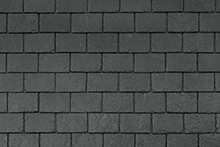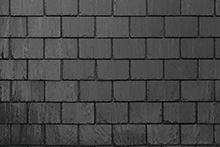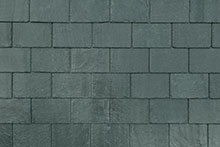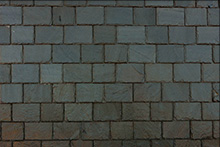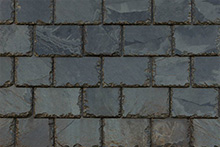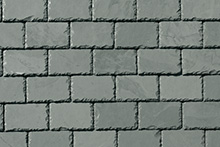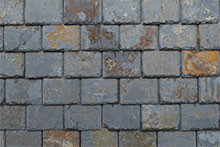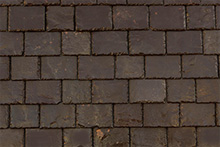California Slate Company, Inc.
Work
3344 Market Street
San Francisco,
CA
94114
USA
+1 (888) 994-0842
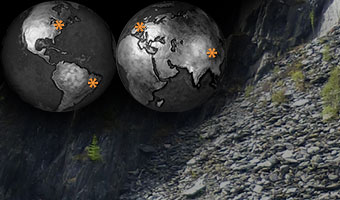
Glossary of Technical Terms
- Absorption
- With regard to slate, absorption is the amount of water retained or soaked into a piece of slate. This is usually a tiny amount. The better the slate, the lower the absorption.
- Apron Flashing
- A flashing located at the low end of a curb or penetration.
- Exposure
- The portion of the slate that is not overlapped by the succeeding courses. It is the portion of the slate that is visible when you look at a slate roof.
- Eyebrow
- A small, shed roof protruding from the main roof or located on the side of a building below the level of the main roof.
- Felt
- A roofing sheet made of interwoven fibers. The fibers can be wood or vegetable for organic felts, glass fibers for fiberglass felts, or polyester.
- Flashing
- Sheets of metal or other material used to weatherproof joints, edges, etc., especially of a roof.
- Flashing Collar
- A flashing component used to seal soil pipe vents, hot stacks or other roof penetrations.
- Gable
- The triangular wall enclosed by the sloping ends of a ridged roof.
- Gable Roof
- A ridged roof forming a gable at each end.
- Gable-On-Hip Roof
- A roof configuration with hips coming up from the eave corners that terminate into a gable roof.
- Gambrel Roof
- A roof with two slopes on each of the two sides, the lower steeper than the other.
- Gutter
- A channel (usually sheet metal) installed along the downslope perimeter of a roof to convey runoff water from the roof to the drain leaders or downspouts.
- Headlap (or Lap, or Margin, or Tail)
- The amount by which a stone slate overlaps the stone slate in the course next but one below.
- Hip
- The angle formed by the intersection of two sloping roof planes.
- Hip Roof
- A roof that rises by inclined planes on all sides of a building. The line where two adjacent sloping sides of a roof meet is called the Hip.
- Mansard
-
- A steep-sloped roof located at the perimeter of a building and usually used for decorative purposes.
- The upper story formed by the lower slope of a mansard roof.
- Mansard Roof
- A roof with two sides on each of the four sides, the lower steeper than the upper. A steeper roof that terminates into a lower sloped roof at its high point.
- Modified Bitumen
- A bitumen modified by one or more polymers such as Atactic Polypropylene (APP), styrene butadiene styrene (SBS).
- Patina, of copper
- A fine crust or film on bronze or copper, usually green or greenish-blue, formed by natural oxidation and often valued as being ornamental.
- Pitch
- The angle of the rafters to the horizontal. The pitch of the stone slates will be significantly less because they are resting on each other, but this is taken into account by the traditional rafter pitch and lap relationship for the slate and the locality.
- Ridge
- The line where two planes of roof intersect, forming the highest point on the roof that runs the entire length of the roof.
- Ridge Cap
- Material applied over the ridge or hip of a roof.
- Ridge Course
- The final course of roofing applied that covers the area where two or more roof planes intersect.
- Ridge Vent
- An exhaust venting device located at the ridge of a roof that works in conjunction with a starter or under eave soffit vent and is used to ventilate attics. Ridge vents and their cooperative starter or soffit vents should be installed at a 1:1 ratio in order to function properly.
- Rivet
- A metal bolt or pin with a head on one end used to fasten layers together by being inserted through holes.
- Roof Jack
-
- A steel bracket fastened to the roof that is used to support toe boards.
- A term used to describe a Pipe Boot or Flashing Collar.
- Roof Overhang
- That portion of the roof that extends beyond the exterior wall line of the building.
- Roof Slope
- The angle made by the roof surface plane with the horizontal plane and expressed as the amount of vertical rise for every twelve inch (12″) horizontal run. For instance, a roof that rises four inches (4″) for every twelve inch (12″) horizontal run, is expressed as having a “four in twelve″ slope; often written as “4:12.” Expressed as a percentage, the slope would be 33%, which is equal to 4 divided by 12. Also known as the Pitch of a roof.
- Slate
- Slate a hard, fine-grained, metamorphic rock that cleaves naturally into thin, smooth-layered surfaces used in steep slope roofing applications.
- Side Lap
- When a course of slate has been laid down, the next or succeeding course should, as close as possible, “split” the course below. Where this is not possible, the offset (or side lap) should be no less than three inches (3″).
- Slating Hook
- A hook-shaped device used to secure roofing slate.
- Slope
- The angle of incline of a roof expressed as a percent or as a ratio of rise to run.
- Starter Course
- The primary course of roofing materials. The Starter course is installed along the downslope perimeter edge and usually covered by the first course of roofing.
- Solder
- A metal alloy used when melted for joining or patching metal parts of surfaces.
- Soffit
- The horizontal underside of an eave, cornice, etc.
- Verdigris
- A green or greenish-blue coating that forms on brass, bronze, or copper.
- Weathering
- The process by which rocks are broken down and decomposed by the action of external agencies such as wind, rain, temperature changes, plants and bacteria. In the development of weathered stone slates, it is often very thin clay or mica beds which are weathered out.



